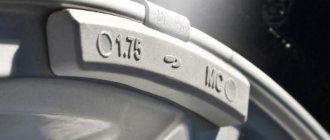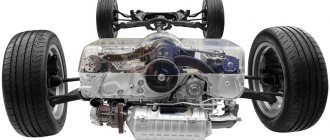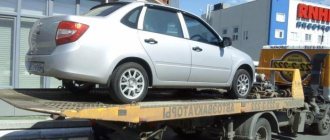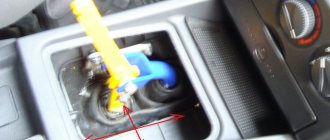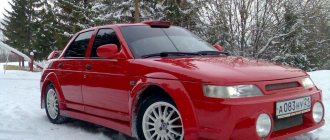There is vibration during acceleration: the main causes of the problem
Author: Dmitry Sapko
There can be a huge number of possible problems with a car, and a specific breakdown does not always give specific signs of its presence. Drivers often complain about body shaking when accelerating or at a certain speed. There can be quite a lot of problems that determine this indicator. If your car has vibration during acceleration, you should look at all possible breakdowns and immediately replace the failed components.
It is not always possible to tell by the nature of the vibration where exactly the problem lies. On different cars, only the steering column can vibrate, putting it in the driver’s hands, but the entire body can shake. It all depends on the design, nature and degree of damage to the components and assemblies that need to be replaced. Let's look at the main causes of vibration during overclocking.
Content
Snow and mud affect wheel balance
One of the most obvious reasons for vibration of the steering wheel at high speed, as well as the entire car, is the clogging of the wheel rims with snow or mud. In this case, the beating is created for some time, and may disappear after accelerating the car, and not occur again, or after a short period of travel. It is quite easy to detect the presence of snow on alloy wheels. The situation is more complicated with steel wheels. They usually have small holes for ventilation, and may also have decorative caps installed. Dirt most often accumulates on the inside of the wheel.
We study wheels and chassis - the main cause of vibrations
The main indicator that the wheels or drives of these same wheels are to blame for your problems is shaking at a certain speed. Often these are body vibrations in the range of 80-100 kilometers per hour, but sometimes the shaking may not go away even after 60 km/h, so in any case you need to fully diagnose the chassis.
In this case, it is not necessary to go to a service station and carry out expensive diagnostic operations. It is enough to apply all your knowledge and study each chassis unit for possible breakdown. The most common problems in this case are the following:
- the wheel mounts are unscrewed, which causes vibration on one of the wheels;
- The brake disc is poorly fixed; at speed it begins to vibrate;
- the wheel drive shaft is bent - the body vibrates constantly, the vibration intensifies when accelerating;
- damaged CV joints - this is the most common problem that causes vibrations on the body;
- The wheel bearings are damaged, which causes shaking at any speed.
The most common problem in this manifestation is CV joints. To check their serviceability, just grab the shaft with your hand and try to turn it. If the shaft has play of more than a couple of millimeters, the CV joint must be replaced. Interestingly, body vibrations during vehicle acceleration can be caused by both external and internal CV joints.
You can also easily determine if there is a problem with this chassis mechanism by examining the anthers. If the rubber part of the boot ruptures, we can safely talk about problems with this mechanism. If water, dust and dirt get into the CV joint, the unit will not survive more than a few days.
Steering wheel shaking when driving at speed
The most common shaking that occurs in a car is the vibration of the steering wheel when driving at speed. It is noteworthy that such shaking of the steering wheel becomes even greater when accelerating. As a rule, the vibration on the steering wheel is barely noticeable at first, but then becomes more and more severe. Be aware that vibration in the steering wheel can cause serious damage that can lead to an accident due to loss of control.
Also, if you do not pay attention to steering wheel vibration, this can subsequently lead to rapid wear of many vehicle components (from tires to transmission).
Therefore, if there is vibration in the steering wheel in your car, you must check the following elements of the car:
—
Check wheel balancing. Contact a tire shop to check wheel balancing. Unbalanced wheels can cause strong vibration in the steering wheel at speed. This is the simplest cause of steering wheel wobble, which can be eliminated without much expense.
— Replace shock absorbers or struts . Worn struts or shock absorbers can cause the suspension to perform unevenly, causing the vehicle to shake. Shaking will be especially noticeable on uneven roads or at high speed.
— Check the strut support bearing . They are located on top of the shock absorbers. From the front you can check them under the hood. If they are worn out, replace these components, which may cause vibration when driving at speed.
— Check and, if necessary, replace ball joints . Ball joints often become unusable due to uneven and bad roads. In our country, ball joints last much less than on cars used in Europe. If these components have play, then when moving, this often leads to shaking in the car.
— Check and replace tie rod ends . Steering ends begin to “loose” over time due to wear. Thanks to them, your wheels turn parallel. If the steering lugs are worn out, the front wheels may not be parallel, which will cause shaking (vibration) in the steering wheel.
Wheel alignment and tire quality are another reason for shaking
If the wheel alignment angle is incorrect, vibration, the car pulling to the side, uneven eating of rubber and other unpleasant manifestations are possible. In different models, these problems manifest themselves in different aspects. Adjusting the wheel alignment angles is one of the first processes that needs to be performed after detecting such a nuisance as body vibration.
Problems can also be caused by tires that are worn incorrectly, or a disc after a serious impact. The main processes that can be taken to eliminate body vibration in this case are as follows:
- adjusting the wheel alignment angle at a wheel alignment station;
- replacing tires if there are visual indicators of uneven or excessive wear;
- replacing or repairing a disc that shows dents and uneven rims;
- performing wheel balancing - often during operation the balancing weights fly off.
If the balancing weights have come off the wheel, this may well cause vibrations at speeds of 80 kilometers per hour. The problem is that it is simply impossible to determine this yourself and find out which wheel needs to be sent for balancing. Therefore, you will have to go to a tire shop and have all the wheels of your car balanced.
This is one of the most inexpensive and safest options for breakdowns due to vibration of the body or steering wheel during acceleration. Therefore, the first thing you need to do is check for the presence of such faults, and then transfer suspicions to other options.
Vibration... - logbook of the 2014 Lada Granta Liftback "Gran(ta) Tourism" on DRIVE2
Hi all! Back in the summer I noticed a slight vibration on the steering wheel after 100 km/h and up to 110, then I attributed it to the Kama 217 (which I was going to retire this year), many, including tire fitters, said that it was crooked from the factory, although before this didn’t happen :)))) I inspected the wheels for hernias and whether the discs were intact, I didn’t give them for balancing... I drove it until I changed it to a winter set... and now there is almost no vibration, but it’s still slightly felt... that means it’s not a weight on one of the summer wheels, but something: 1) A grenade? I once wrote that the right drive moves slightly away from the axle, so it doesn’t seem like it should be? 2) Are the brake discs moving? 3) Could this be due to slightly tired A-pillars? In general, a question for experts :)))) What is this? In principle, this problem does not bother me much, but still it shouldn’t be like this... I repeat once again, this happens at speeds of 100-110 km per hour, slower or faster is normal!
Issue price: 100,500 ₽ Mileage: 33,600 km
Likes 162 Shares: Subscribe to car
www.drive2.ru
Engine mounts, tie rods and other problems
There is another group of problems that cause vibrations when accelerating a car. It is difficult to collect these problems into one bundle, because they are all different and arise for various reasons. Vibration often occurs when one of the engine mounts is broken. This can easily be checked by increasing the speed while shaking.
The gearbox may also be the culprit for this type of problem. If the car starts to shake at 80 kilometers per hour, you can very easily check the fault of the gearbox by performing the following procedures:
- accelerate to a speed of about 85 kilometers per hour;
- depress the clutch and observe the vibration change;
- engage third gear and smoothly release the clutch;
- try accelerating from 50-55 kilometers per hour in last gear.
What harm can vibration in a car cause?
It is quite clear that the amount of damage depends greatly on which particular unit caused the shaking of the car. If the engine mount is the culprit, for example, then a constant increase in shaking can cause a number of problems in the power unit. Increased vibration of exhaust system elements will lead to destruction of mechanical connections in this system and premature failure of a number of components.
There are also general consequences of constant strong vibration:
- increased wear of interior parts that do not like vibration, since hard plastic will actively rub against other elements and wear out;
- failure of seals that do not tolerate vibration loads, this is fraught with leakage of some technical fluids and depressurization of components;
- loss of tightness of antifreeze circulation systems; clamps may become loose, causing coolant to drip into the connections;
- maximum discomfort of traveling in a car, which can cause fatigue on long trips and decreased concentration;
- a gradual increase in vibration resonance can make it completely impossible to drive a car at a certain speed.
You should not delay calling for service if you notice vibrations and resonance in your car. Perhaps you just need to change the rubber muffler hangers to get everything back to normal. You don't necessarily have to expect expensive and complicated repairs. So it is very important to contact specialists in time for diagnostics in order to reduce the discomfort of operating the machine and significantly reduce the cost of repair work.
For useful tips on some possible causes of shaking, watch the video:
see also
Comments 47
Just like mine, 1:1, and I changed the drive and the brake discs vibrate even if you crack it, it’s already drained my whole soul. It's a pity that we couldn't find the reason...
A huge possibility is the steering rack. Either change it or improve it.
I'll have to look, it's just knocking on me, thank you)
They come from the factory unlubricated, which is why they break immediately. Apparently for you and me it also came out with some play.
Yes, may be. It seems like it was never touched from the factory, although at the maintenance they said that it was adjusted (the nut was clogged once at the factory and remained so). Last year I added lubricant through the anthers, maybe it became a little easier to walk
If they are dealers, then they are lying. I had to drive the car to them three times. Engine problem. Until I filed a complaint, the car was not repaired. There was a factory defect. The pistons were installed with a smaller diameter. And there were three such cars in our city.
Yes, off dealer. I swore because of the knocking of the rack when it was cold, it was also a whole epic
interesting topic . I have a service liftback. same problem . did you find a solution?
Don't know. I haven't had this car for three years now. At the moment my version is the steering rack. Most likely it comes with a defect and has a backlash. The play may appear at speed.
Same crap, mileage 25 thousand after a couple of big potholes - killed 2 discs, vibration appeared at speeds of 90-110, at the station they say everything is fine with the suspension, straightened the broken discs and threw them back. (vibration is felt in the pedals and steering wheel)
Maybe you also damaged the steering rack?
Anything can happen... So what now to change the wheel bearing, CV joint assembly, rods, levers, disc, rack and steering wheel at the same time? ))
I think start with something simple. Install the amplifier shield on the steering rack. It doesn't cost much. Because when I was struggling with vibration, I replaced the entire right-hand drive assembly and nothing changed. Only about 8 thousand rubles. thrown to the wind. If it hits the pedals, I'll try replacing the brake discs. Perhaps they were not sharpened smoothly when braking.
And sometimes at a speed of about 100 km/h I have vibration, and sometimes there is none. Depends on where you're going. Although the asphalt seems to be smooth and this was not the case with other cars in these areas. As a result, I scored and decided that this was the coating.
I also noticed this phenomenon, you drive in 5th gear, the speed is 110-120 km/h, you press the gas pedal to accelerate, there is no vibration, as soon as you release the gas pedal to coast or drive down a mountain, when you don’t load the engine, vibration appears.
I just had a smooth ride. without acceleration and without coasting. it even looked like a slight beating. At first I even thought that the wheels were not screwed on well and checked all 4 wheels at once, but everything turned out to be normal.
About overclocking, I tried it, how the shaking manifests itself.
I once wrote about approximately the same problem. It (the problem) lies in the operation of the gearbox differential, or rather the satellites - with different loads on the wheels, the transition of forces from one axle shaft to another, especially when turning, can cause a slight vibration. It's front-wheel drive, that's how it should be. I also experience vibration at about 100 mph under light loads.
Beating in the steering wheel: First joke: it depends on the imbalance of the tires - mine was from 70-90, then it went a little higher - the solution is stupid - I moved the front to the rear, reeled in another 3 thousand - silence. Then I went to the winter ones, in the spring before changing shoes - I went to a neighbor's place - changed the weights - put them on as they were from the factory - silence. The second joke you can find out yourself: jack up the front on either side, don't put the car at speed, but just put the rear wheels in anti-roll mode on the handbrake pinch. You need a chalk and a lining: you put the chalk on the lining under the wheel - there is a gap of 1-2 mm and turn the wheel - where the rubber or disk sticks out, if it’s not “snapped”, but “by eye the gap has become larger - well, I put a point there. In general, vertical runout of a disk or rubber. Rubber: most likely change it, as an option, look for “nickels” on the surface - usually they are slightly chewed and the tread will show different wear. Disc: for repair at a GOOD STAND and in GOOD HANDS. The third joke: partially echoes the first and second: the tread is “eaten up” by “nickels” - the result is an imbalance of weight and unevenness of the tread, this is looked for by inspecting the tires in good lighting, the solution is - if there is little wear - balancing, if there is a lot of wear - change the stroller, in rare cases it saves chamber - changes the pressure distribution in the wheel. Example of wear (nickels are already large) - www.autoprospect.ru/volks...en/touareg/images/667.jpg
Let's sum it up
If you are unable to find the problem that is causing the body or steering wheel to vibrate in your car when accelerating, you should contact a professional. Do not leave this problem, because it can worsen and create dangerous travel conditions for the driver and passengers of the car. It is necessary to respond as quickly as possible to all possible problems and eliminate them by replacing failed machine elements.
Often, to determine the problem, you don’t even have to go to a service station and use expensive diagnostics. It is enough to inspect the car yourself and determine what problems caused the body vibrations. Have you had similar problems in your experience, and what parts of the machine caused them?
Source
Ways to solve the problem
Whatever the reasons for the steering wheel beating, it is necessary to carry out high-quality diagnostics and eliminate the problems. This will make it possible to avoid expensive repairs, and most importantly, prevent accidents!
If the steering wheel shakes at low speed, proceed as follows:
- check the cleanliness of the wheel rims;
- check the balancing and fastening of bolts on the wheels;
- test discs for deformation;
- check the quality of rubber;
- diagnose the suspension;
- examine brake discs and drums;
- check the engine mounting;
- try the quality of the drive shaft.
Wheel rims are easier and faster to clean at a car wash. A stream of water will remove accumulated dirt. Hit the disc with some object, reducing the amplitude of vibrations of the steering wheel, in order to safely drive to the car wash or service station.
Have your balancing done at a tire shop. Balance all 4 wheels, especially if the steering wheel shakes at low speeds. At the same time, eliminate the deformation of the wheel rims and give them their initial shape on a straightening machine.
Replace defective tires. It will not be possible to restore it - you will have to buy new tires and mount them according to the canons of proper balancing.
Steering wheel wobble at speed due to a faulty suspension or steering mechanism is “treated” by disassembling the chassis, inspecting the parts and fixing the problem. More often than others, grenades (CV joints), rubber-metal joints, and steering bushings break.
The beating that occurs during braking can be eliminated at a service station. The machine grinds and restores the surface of the brake discs if the degree of wear is low.
It is better not to fix steering wheel wobble at speed yourself. Only car services will accurately determine the cause of the breakdown and eliminate it. Most workshops work with specific brands of cars; they have a better understanding of the specifics of the models, know the characteristic “sores” and are able to quickly recognize them.
After using the car for a long time, many drivers stop noticing the steering wheel vibrations that occur. But sometimes such beating is a consequence of vehicle malfunctions, and if they are not corrected in a timely manner, driving safety can be greatly reduced.
Vibration appeared during acceleration. Almost dismantled the entire chassis until I found the reason
Various vibrations and shaking of the car body are a clear reason to check the serviceability of the car.
This problem started bothering me not so long ago, but the symptoms are still unpleasant - as soon as the car starts to actively pick up speed, the body just shakes and vibrates.
In the article I’ll tell you, using a personal example, where you can climb, what to check and see in order to get rid of this unpleasant shaking.
I'll look at a few common reasons.
Lada Granta Liftback Luxury Platinum › Logbook › Vibration at idle.
Hello everyone! I had a problem at 23,000. At one point I realized that my car began to work like a tractor. As soon as the engine warmed up, the revolutions dropped and the idle speed dropped to 800-850, there was vibration throughout the body. It was especially noticeable on the steering wheel, on the open door and when you sit in the driver's seat, the feeling of vibration massage does not leave me. I went to the OD, they looked and looked, but alas... They replaced the muffler corrugation and the engine mount under warranty, but no result happened. After that, on the third visit to the OD, they began to convince me that it was normal vibration is “acceptable”, which I strongly doubt. Firstly, it didn’t exist until 23,000, and secondly, my friends don’t have it in the same cars. In general, the mileage is 36,000, and the result is zero.” Plus one back massage. I WANT TO CONTACT TO ALL OWNERS OF LADA GRANT WITH A REQUEST FOR HELP. MAYBE ANYONE HAD THE SUCH PROBLEMS! THANK YOU IN ADVANCE! P.S: Currently, a claim is being prepared for AvtoVAZ, Rospotrebnadzor and OD.
Mileage: 36000 km
Likes 33 Shares: Subscribe to car
www.drive2.ru
The main reason was as follows
My car has an automatic transmission and when coming to a complete stop in Drive mode there was a noticeable vibration. The reason for this is broken engine and automatic transmission mounts.
After conducting a little investigation, I came to the conclusion that vibration during acceleration “grows its legs” from here.
It turns out that when accelerating, the engine and automatic transmission shift to the side due to sagging cushions
. This in turn creates additional load on the already internal CV joint. It is unable to work in angles that are inappropriate for it, which is why vibration occurs.
In this case, it is necessary to change not only the internal CV joint, but also the engine mounts and automatic transmission. After replacing all this, the vibrations seemed to never exist
Source
Reason 1 – spark plugs
Spark plugs are the first thing to check when the Priora jerks while driving. If they were rarely changed and the car was filled with low-quality fuel, carbon deposits could appear on the electrodes. This leads to misfires, as a result of which the car begins to twitch while driving.
The cost of candles for Priora varies greatly depending on the manufacturer. The simplest ones cost 250 rubles for four pieces.
You can change it yourself if you have a spark plug wrench, or contact service. The service costs from 400 rubles depending on the technical center.
Reason 2 - ignition coils
The signs of this malfunction are the same as for spark plugs - misfire. As a result, the Priora jerks at speed, and the revs drop when the gas is sharply pressed. The reason may be candles - they are either of low quality or incorrectly selected.
The malfunction can be determined by pulling out the ignition coils one by one. If you disconnect a working coil, the tripping will increase, but if you disconnect a faulty coil, there will be no change.
The issue price is from 850 rubles for an analogue.
Reason 4 – fuel filter
This is perhaps one of the most common reasons why the Lada Priora twitches.
Like any other filter, the fuel filter becomes clogged over time. The reason is low-quality fuel and dusty air, so it is better to refuel at proven gas stations.
You can check a clogged filter yourself using a conventional pressure gauge, tube and clamp. For this:
- Unscrew the cap from the fuel rail fitting.
- Using the tire nipple cap, unscrew the spool and connect the pressure gauge, securing the tube with a clamp.
- Start the car and check the pressure reading. If it is less than normal - 3.8-4 kgf/cm2, the cause of the twitching most likely lies in the filter.
At a service center, a pressure check service will cost about 300 rubles.
You can replace the fuel filter at home. The part costs about 300 rubles. If there is no desire or opportunity, contact the service center. There they will charge from 500 rubles for the service.
Reason 5 – mass air flow sensor or ECU firmware
A malfunction of the mass air flow sensor on a Priora leads to the control unit receiving incorrect data on the amount of incoming air, as a result of which the air-fuel mixture is not prepared correctly, and the car may begin to twitch. The malfunction is determined using diagnostics at a service center.
The price of the sensor is not at all budgetary for a Priora - about 4,000 rubles. You can change it yourself. To do this, first disconnect the negative battery terminal, then the wire connector and unscrew the pipe clamp. After this, use a wrench to unscrew the two screws securing the air filter housing and carefully remove the sensor.
Inappropriate ECU firmware leads to the same symptoms. The air-fuel mixture is not prepared correctly, and interruptions may occur during engine operation. This can be caused by improper chip tuning or a malfunction of the “brains” themselves. In any case, only competent diagnosis will help here. It usually costs about 500 rubles. After diagnosis, the technician will tell you exactly how to solve the problem.
